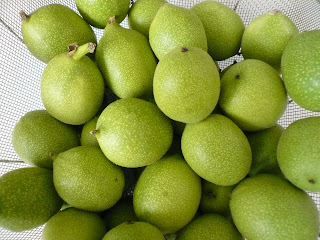My boyfriend had spent many Mardi Gras's in New Orleans in his youth and has more experience in eating gumbo than I or anyone I knew, and I wanted his help. Unfortunately, all the help he gave me was that I should find a good recipe and follow that. For soups and stews, I usually don't like following recipes and can't judge a good one just from reading it anyway, so I decided to wing it. The goal was for the gumbo to taste "good," and I think it came out pretty good. When my boyfriend tried it, he was quite annoyed that I had nailed the flavor without knowing what gumbo is supposed to taste like nor following a recipe so that was a bonus because I wasn't really aiming for authenticity of flavor.
In any case, here is a rough description of what I did:
Ingredients:
1 pound of thick cut applewood smoked bacon, cut into small pieces
About 1 pound of shell-on shrimp, peeled and de-veined.
About a haf cup of all-purpose flour
Two chicken breasts cubed (I happened to have these on hand)
2 green bell peppers, chopped
1 large onion diced
2 garlic cloves
Some okra
Sassafras
Toasted garlic and toasted garlic oil
Fish Sauce
Bay leaf
Salt
1. Crisp the bacon in a dutch oven and remove it. Leave the drippings in the dutch oven and mix in the all purpose flour. Yes, you need ALL those drippings; don't remove ANY of it. The mixture of fat and oil is called a roux. I also added in a couple cloves of garlic to infuse into the roux. I removed it when it started to turn golden brown. I mashed the garlic cloves and set them aside.
2. Cook the roux over low heat until it changes color. According to Alton Brown, it's supposed to be brick red and gives gumbo its characteristic flavor. I had never done this before, and chickened out when it got pretty dark brown. Next time I'll be more brave in letting it go darker.
3. While the roux is darkening, make a broth with the shrimp shells. Heat about a quart of water in a saucepan until boiling and add the shrimp shells. For those of you who don't know me, I'm fanatical about "clean" broths and stocks so I skimmed off all the scum, foam and other smelly things that float to the top. I let this simmer for about 20 minutes, skimming off the scrum the whole time to make sure that it doesn't redesolve back into the broth and make it cloudy and smelly. Don't forget to stir and watch the roux. When the shrimp broth is done, drain out the shells and return the broth back to the saucepan. Heat it to a boil, add a pinch of salt and fish sauce and add the shrimp a bit at a time to cook. Cooking the shrimp in the shrimp broth will make both items more flavorful. Don't overcook the shrimp -- remove them and set aside as they finish cooking. Remember to remove all scum that forms in the broth while the shrimp are cooking.
4. After all the shrimp are cooked, add the cubed chicken to the broth to cook a bit at a time in the shrimp broth. Again, take out all the scum that floats to the top of the broth as the chicken cooks since it will release its own protein impurities. Cooking the chicken in the shrimp broth will make the chicken flavorful and the broth more flavorful as well. Remove the chicken cubes as they finish cooking and set aside.
5. When the roux is finished, add the chopped bell peppers and onions, cook for a bit over med/high heat and then add the shrimp/chicken broth. When heated through, add the bacon, mashed garlic, shrimp, chicken, crispy fried shallots, and toasted garlic and garlic oil and let simmer for a few minutes.
6. To serve, ladle into bowls and top with toasted garlic oil and sassafras to taste.
Crispy bacon:
Bacon drippings:
Bacon drippings and flour
Roux starting to develop color
More color

















